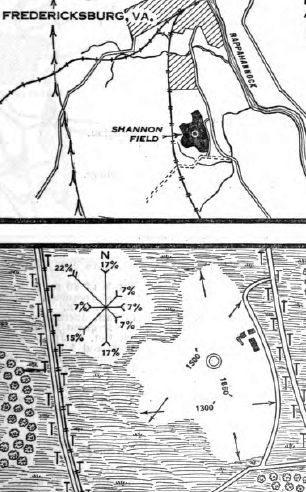
Abandoned & Little-Known Airfields:
Eastern Virginia
© 2002, © 2016 by Paul Freeman. Revised 12/4/16.
This site covers airfields in all 50 states: Click here for the site's main menu.
____________________________________________________
Please consider a financial contribution to support the continued growth & operation of this site.
A. P. Hill AAF #2 / Port Royal AAF (revised 5/4/14) - Burgess Airfield (revised 5/8/13) - Harbor View Airport (revised 5/4/14)
Moss Neck AAF #3 / Pender AHP (revised 10/24/08) - Reno Skypark (revised 6/23/06)
Shannon Field (original location) (revised 12/4//16) - Tappahannock Flight Strip / Tapphannock Municipal (revised 6/15/14)
____________________________________________________
Shannon Field (original location), Fredericksburg, VA
38.277, -77.456 (South of Washington, DC)

The original location of Shannon Field, as depicted on the 7/10/29 Commerce Department Airway Bulletin.
Photo of of the airport while in use has not been located.
The original location for this small general aviation airport was located a half-mile northwest of its eventual location.
According to the current Shannon Field website, Sidney Shannon learned to fly in 1927 at Hoover Field, across the river from Washington DC.
He opened the first Shannon Field in the 1920s.
According to the book "Virginia Airports" by Vera Rollo & Norman Crabill (published by the VAHS),
“Sidney L. Shannon Sr. opened a turf airstrip, Shannon Airport,
with a single building, on the family farm in Fredericksburg.”
The earliest depiction which has been located of Shannon Field was a 7/10/29 Commerce Department Airway Bulletin.
It described Shannon Field as a 60 acre irregularly-shaped sod field measuring 1,850' north/south.
Three hangars were depicted on the east side, and the owner & operator were listed as S.L. Shannon.

The earliest aeronautical chart depiction which has been located of Shannon Field was on a 1930 Air Navigation Map.
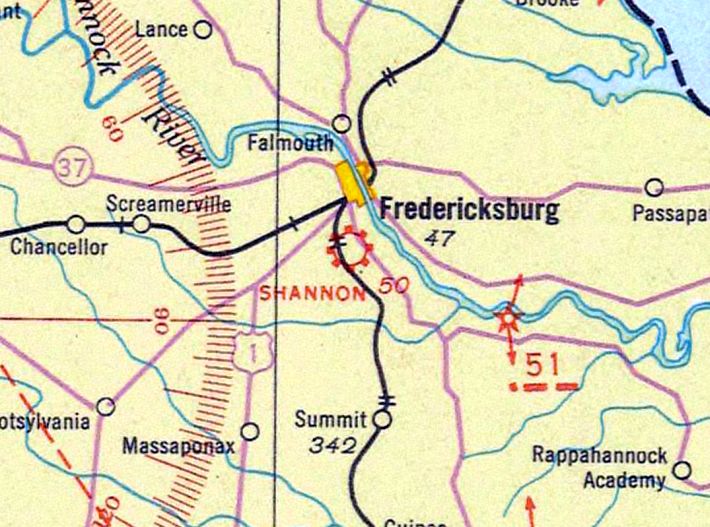
The 1935 Washington Sectional Chart depiction Shannon Field as a commercial/municipal airport.

The 1943 USGS topo map depicted the original Shannon Field as an irregularly-shaped property outline, labeled simply “Landing Field”,
with 2 small buildings on the east side.
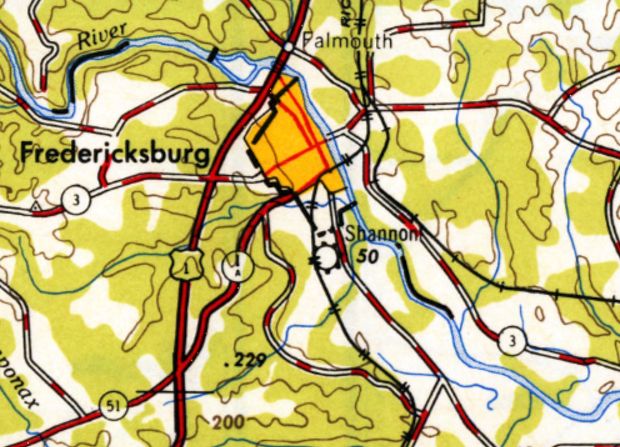
The original location of Shannon Field as depicted on the 1948 USGS topo map.

The last aeronautical chart which depicted the original location of Shannon Field was the 1949 Washington Sectional Chart.
It depicted Shannon Field as having a 2,800' unpaved runway.
The original location of Shannon Field was evidently replaced at some point between 1949-51,
as the 1951 Washington Sectional Chart depicted Shannon as having been relocated to its eventual location, a half-mile further southeast.

A 3/1/60 USGS aerial view showed the county fairgrounds occupying the site of the original Shannon Field,
with possibly a runway outline still recognizable along the north side of the property.
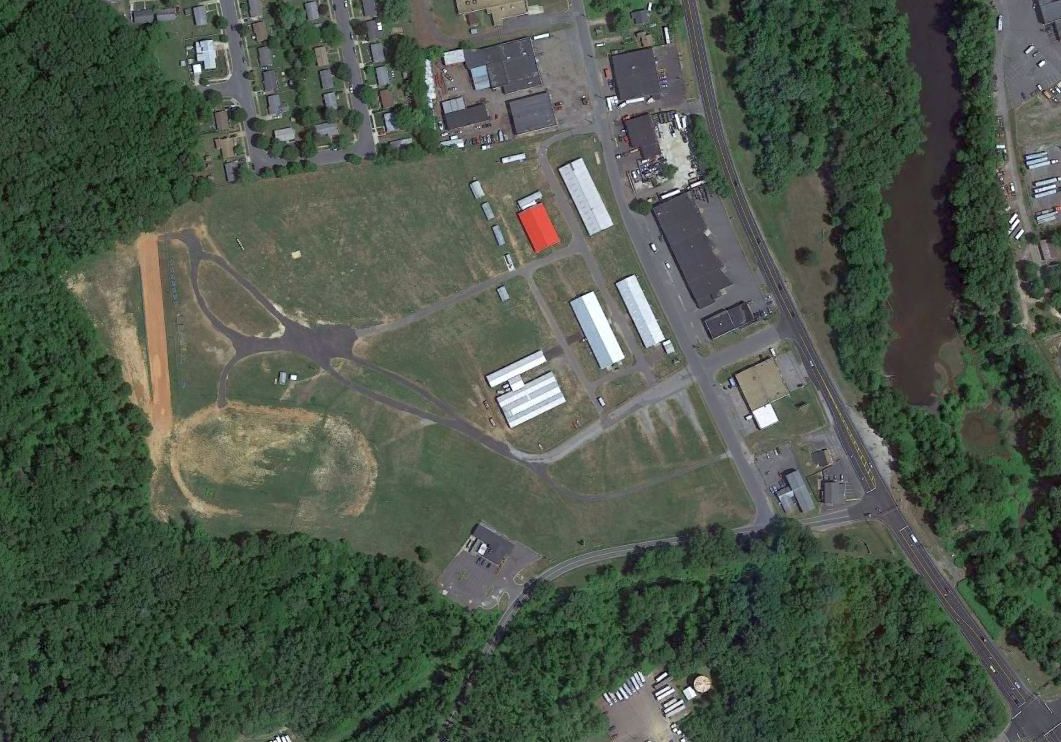
A 2015 aerial view showed no trace remaining of the original Shannon Field.
The site of the original Shannon Field is located west of the intersection of Oldfield Street & Airport Avenue, appropriately enough.
____________________________________________________
Burgess Airfield, Dahlgren, VA
38.35, -77.07 (Northeast of Richmond, VA)

The earliest depiction which has been located of Burgess Airfield was on the 1949 Washington Sectional Chart (courtesy of Mike Keefe).
This private airfield was located directly across Route 301 from the Navy's Dahlgren airfield.
According to Clifton Huston, “ I believe it was named for a local King George County resident 'Blue' Burgess.”
Burgess Airfield was evidently established at some point between 1946-49,
as it was not yet depicted on the 1946 Washington Sectional Chart (courtesy of Mike Keefe)
nor on the 1946 USGS topo map.
The earliest depiction which has been located of Burgess Airfield was on the 1949 Washington Sectional Chart (courtesy of Mike Keefe).
It depicted Burgess as having a 2,800' unpaved runway.

The only photo which has been located showing Burgess Airfield in operation was a 3/27/52 aerial view.
It depicted the field as having 2 grass runways,
with 4 single-engine aircraft & a few small buildings at the south end of the field.

The most detailed depiction which has been located of Burgess Airfield was on the 1955 USGS topo map (courtesy of Clifton Huston).
It depicted Burgess as having 2 perpendicular unpaved runways, on the northwest side of Route 301.
Two small buildings were depicted on the south side of the field,
but it is not known if these buildings were airfield-related.
According to the book "Virginia Airports" by Vera Rollo & Norman Crabill (published by the VAHS),
“Burgess Airport was a personal field with 3 turf strips, unattended.”

The last depiction which has been located of Burgess Airfield was on the 1960 Washington Sectional Chart (courtesy of Mike Keefe).
It depicted Burgess as a private field having a 2,600' unpaved runway.
Burgess Airfield was evidently closed at some point between 1960-64,
as it was no longer depicted on the 1964 Washington Sectional Chart.
Its closure was probably related to the fact that it was located directly across the road from the Navy's Dahlgren facility.
A 1967 aerial view showed that houses had been built covering the southeastern runway,
but the majority of the northeast/southwest runway remained clear.
The 1968 USGS topo map (courtesy of Clifton Huston) no longer depicted the runways,
but instead showed that the southeastern end of the former southeast/northwest runway had become a street (Danube Drive) lined with homes.
The 1983 USGS topo map (courtesy of Clifton Huston)
showed that the northeast/southwest runway had also become a street (Delaware Drive) lined with homes.
The Burgess family may have reestablished their airfield a few miles to the northwest, across the Potomac River,
as the 1988 USGS topo map depicted a Burgess Field in Riverside MD.

A 2002 aerial view showed no remaining recognizable trace of Burgess Airfield.
The site of Burgess Airfield is located northwest of the intersection of Route 301 & Danube Drive.
Thanks to Clifton Huston for pointing out this airfield.
____________________________________________________
Tappahannock Flight Strip / (Original) Tappahannock Municipal Airport (W79),
Tappahannock, VA
37.925, -76.872 (Northeast of Richmond, VA)

The Tappahannock Flight Strip, as depicted on the 1944 Regional Aeronautical Chart (courtesy of Chris Kennedy).
This airfield was originally built during WW2 as one of numerous Flight Strips constructed across the country,
which were intended to be used as emergency airfield by military aircraft.
The Tappahannock Flight Strip was evidently built at some point between 1943-44,
as it was not depicted the 1943 Regional Aeronautical Chart (courtesy of Chris Kennedy)
nor the 1944 USGS topo map.
The earliest reference to the airfield which has been located
was in the 4/1/44 US Army/Navy Directory of Airfields (courtesy of Ken Mercer),
which described the "Tappahannock Flight Strip, Army"
as having a 4,000' hard-surfaced runway, with a total landing distance of 8,000' available.
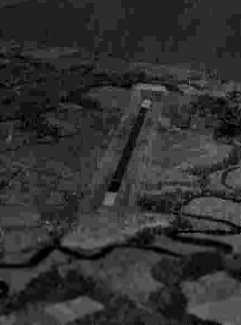
The earliest photo which has been located of the Tappahannock Flight Strip was a circa 1943-45 aerial view looking north
from the 1945 AAF Airfield Directory (courtesy of Scott Murdock) depicted the field as having a single asphalt runway.
The 1945 AAF Airfield Directory (courtesy of Scott Murdock) described Tappahannock Flight Strip as “Inactive”.
The field was said to consist of a single 4,000' asphalt NNE/SSW runway, and to not have any hangars.
The field was described as being owned & operated by the VA State Highway Department.
At some point between 1945-53, the Tapphannock Flight Strip was reused as a civil airport.
The July 1953 Chesapeake Bay USAF World Aeronautical Chart (courtesy of Chris Kennedy)
depicted "Tappahannock FS" as having a 5,000' hard-surface runway.
The 1961 USGS topo map depicted a single paved 6,100' northeast/southwest runway, labeled simply as “Landing strip”.
By the time of the 1965 Norfolk Sectional Chart (courtesy of John Voss),
Tappahannock's usable runway length had been reduced significantly, to only a 3,000' bituminous strip,
as a displaced threshold had been applied to the southern end.
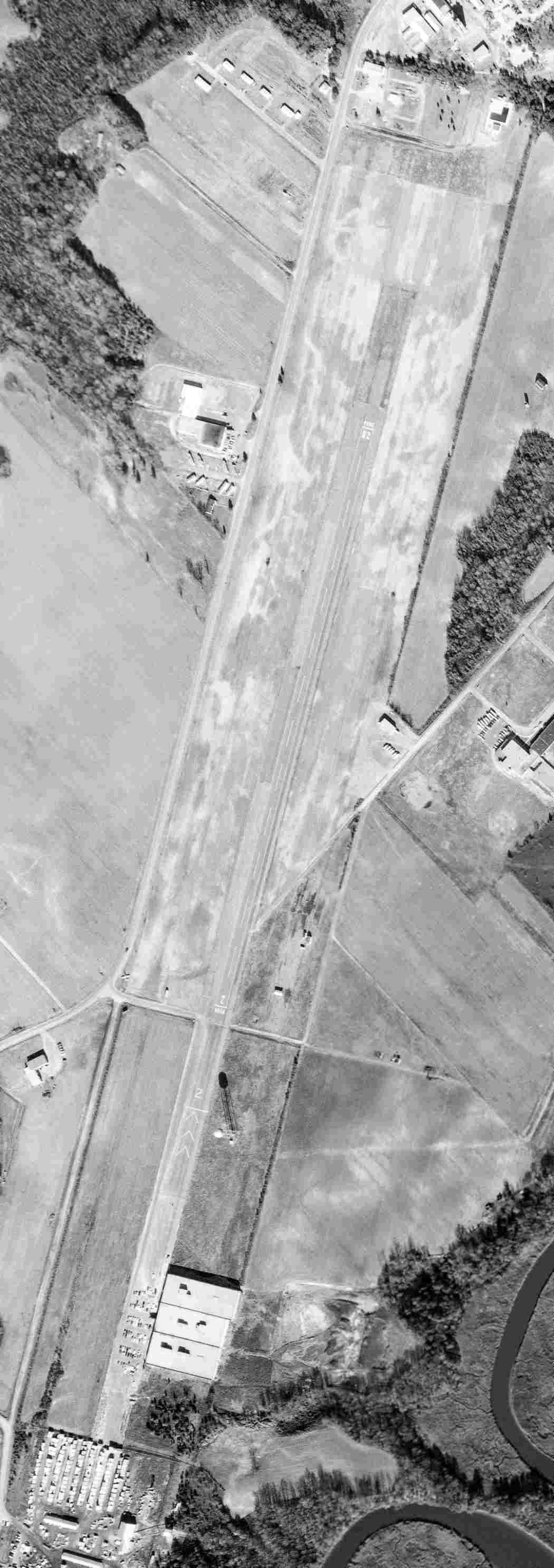
A 1/13/67 USGS aerial photo showed only a single light aircraft visible on the field.
A factory had been built adjacent to the southeast side of the runway at some point between 1945-67.

The 1968 Virginia Airport Directory (courtesy of Don Thompson)
depicted Tappahannock Municipal Airport as having a single 2,800' paved Runway2/20,
with a 50' width having been newly paved, over an original 150' width of “old pavement grass growing through cracks”.
An “administration trailer” was depicted across the street to the west,
but there were no hangars depicted.
The operator was listed as the Town of Tappahannock, with the manager listed as G.C. Clanton.
The “Industrial Building” was depicted adjacent to the southeast side of the airport (a denim factory),
as well as the water tower.
Several improvements were made at Tappahannock during the 1960s,
when Priority Air Dispatch ran an air courier service there,
according to a historical account displayed in 2008 in the new Tappahannock Essex County Airport.
Improvements included a hangar & terminal building.
The 1971 USGS topo map depicted a single paved 3,200' northeast/southwest runway, labeled simply as “Landing strip”,
with a road crossing the southern portion of the runway,
and a factory having been built adjacent to the southeast end.
Priority Air Dispatch had ended their operations at Tappahannock by the 1970s
(according to a historical account displayed in 2008 in the new Tappahannock Essex County Airport),
and the airport went into a period of decline.
The 1980 USGS topo map labeled the site as Tappahannock Municipal Airport.
The 1982 AOPA Airport Directory (courtesy of Ed Drury) listed the field's operator as Essex Aviation Inc.

An undated view of a Cessna passing nearby to the water tower at Tappahannock,
from the International Flying Farmers Magazine (courtesy of Kenneth Keeton).
The picture was captioned, “What looks like a close encounter of the 3rd Kind is really Hank & Mabel Osterhout landing at Tappahannock
for the Virginia Flying Farmers March meeting.”
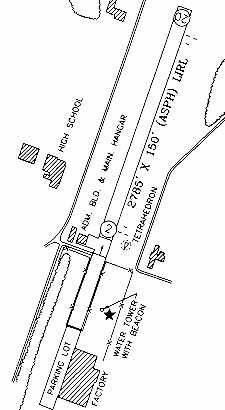
The 1998 VA Airport Directory depicted Tappahannock as having a single 2,785' asphalt Runway 2/20,
with an administration building & main hangar on the west side (which had evidently been added at some point between 1969-98).

An undated (circa 1990s?) photo showing several Cessnas at Tappahannock.

A circa 1990s aerial view looking north at Tappahannock.
Paul Freeman flew a Diamond Katana DA-20 into Tappahannock in 1999.
The airfield had a very unusual configuration:
a large factory sat directly adjacent to the southeast side of the runway.
Most of the lower section of the original runway had been fenced off
& was used as a parking lot for the factory.
As a result, the threshold of Runway 2 had been significantly displaced,
reducing the length of the maintained runway to only 2,785'.
Plus, a tall water tower sat very close to the runway, just north of the factory.
These obstacles combined to make an approach on Runway 2 very uncomfortable
(even with the significantly displaced threshold).
Tappahannock was still in use (as of 2002) as a general aviation airport,
but the county government had plans to eventually replace Tappahannock
with a newly constructed Tappahannock Essex Airport at Paul's Crossroads (3 miles to the southwest).
When the new airport was opened the original airport would be closed,
and the property would be redeveloped as an industrial park.
The Essex County Government web site said that
"Essex county began the land acquisition at Paul's Crossroads for the new airport in 1999."

A 5/13/05 photo of a hangar at Tappahannock Municipal Airport.

A circa 2005 aerial view of the original Tappahannock Municipal Airport
showed a total of 10 light aircraft parked on the ramp on the west side of the field.
The factory adjacent to the southeast side of the runway was occupied by H. Warshow & Sons, an auto-parts operation,
until it closed in 2005, according to an article in the 1/5/07 issue of the Richmond Times-Dispatch.

A July 2006 aerial view by Alex McMahon looking west at the old Tappahannock Airport.
As of 2007 the FAA Airport/Facility Directory listing for the original Tappahannock Municipal Airport
described the field as being owned by the Town of Tappahanncok,
with the manager listed as Linwood Wadsworth.
Tappahannock was said to have 16 single-engine aircraft based on the field,
and it was said to host a total of 581 takeoffs or landings per month.

A 3/18/07 aerial view by Peter Palafoutas, taken on final approach for Runway 2.
Three single-engine aircraft were visible near the hangar on the west ramp.
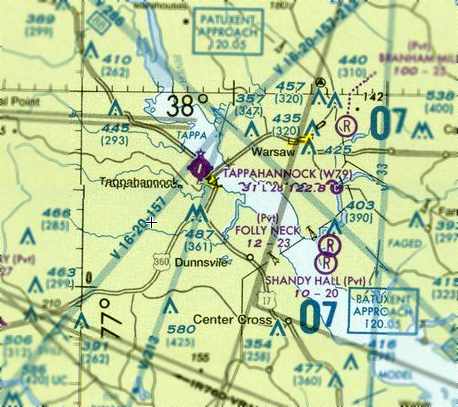
The last aeronautical chart depiction which has been located of the original Tappahannock Airport
was on the August 2007 Washington Sectional Chart.
It depicted Tappahannock as having a single 2,800' paved runway.
According to Orville Ingram, the local newspaper reported that the new Tappahannock-Essex Airport opened on August 18, 2007,
with a 4,300' paved runway with clear approaches (a considerable improvement over the old airport).

The last photo which has been located showing based aircraft at the original Tappahannock Airport was a 9/15/07 aerial view by Seth Cassaday looking northeast.
According to Seth, “The old airport stayed open for some time but only to pilots that were based there.”
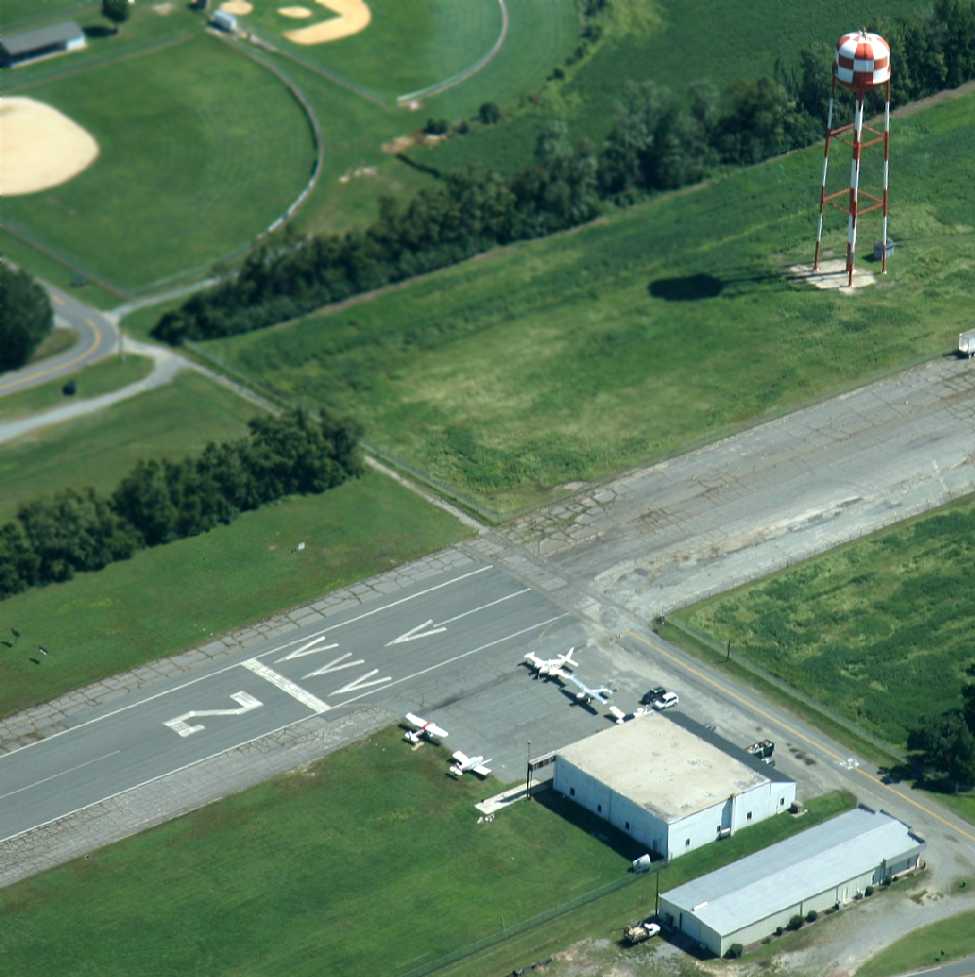
A 9/15/07 aerial view by Seth Cassaday looking east at the planes on the Tappahannock Airport ramp.

The old Tappahannock Municipal Airport evidently got a large visitor a few years after the airport closed,
as 6/12/10 USMC photo by Tammy Hineline showed a CH-53E Super Stallion helicopter on the Tappahannock runway
during a community outreach day held by the 26th Marine Expeditionary Unit to thank the local community
for their patriotic support & hospitality during Realistic Urban Training at nearby Fort A.P. Hill.
The original Tappahannock Municipal Airport is located south of the intersection of Route 17 & Airport Road.
____________________________________________________
A. P. Hill Army Airfield #2 / Port Royal AAF, Port Royal, VA
38.16, -77.195 (South of Washington, DC)

"Hill #2 (Army)" Airfield, as depicted on the October 1948 Washington Sectional Chart (courtesy of Chris Kennedy).
Photo of the airfield while in use has not been located.
The 76,000-acre Fort A. P. Hill was established as an Army training facility on 6/11/41.
During World War II, the Fort operated as a training site for corps & division-sized units.
The second of what would eventually total 4 airfields within the bounds of the Fort
was evidently established at some point between 1947-48,
as no airfield at this location was depicted on the 1942 USGS topo map
nor the April 1947 Washington Sectional Chart (according to Chris Kennedy).
The earliest depiction of this airfield which has been located
was on the October 1948 Washington Sectional Chart (courtesy of Chris Kennedy).
It depicted "Hill #2 (Army)" Airfield as having a 2,100' unpaved runway.
The 1952 USGS topo map depicted “Hill Airstrip #2” as having a single southeast/northwest runway,
bisected by an unpaved road.
"Hill #2 (Army)" Airfield was depicted on the January 1954 Washington Sectional Chart (courtesy of Chris Kennedy)
as having a 2,100' unpaved runway.

"Hill #2 (Army)" Airfield was depicted on the August 1957 Washington Sectional Chart (courtesy of Chris Kennedy)
as having a 2,100' unpaved runway.

The field had evidently been renamed " Port Royal AAF (#2)" at some point between 1954-60,
as that is how it was listed in the 1960 Jeppesen Airway Manual (courtesy of Chris Kennedy).
The field was depicted as consisting of a single 2,284' unpaved Runway 14/32.
A cluster of small buildings was depicted just north of the airfield,
but none of the buildings appeared to be directly related to the airfield,
which was described as being unattended.
Port Royal AAF was still depicted as an active airfield
on the February 1962 Washington Sectional Chart (according to Chris Kennedy).

Port Royal AAF #2 (and the other 3 Camp AP Hill Army Airfields), as depicted on the 1963 USGS topo map.
The 1964 USGS topo map depicted “Hill Airstrip #2” as having a single southeast/northwest runway,
bisected by an unpaved road.
Port Royal AAF was evidently closed (for reasons unknown) at some point between 1962-64,
as it was no longer depicted at all on the October 1964 Washington Sectional Chart (courtesy of Chris Kennedy),
or subsequent aeronautical charts.
A 1967 aerial view depicted the airfield site as an open grass field.
The 1971 USGS topo map no longer depicted the airfield.
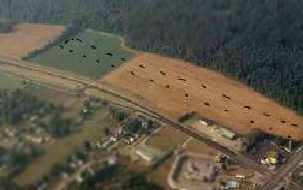
A 1993 aerial view by Ray Tyson looking south at the airfield (the outline of which has been annotated),
which was evidently also known as “Nottingham Field”.
A 1994 USGS aerial photo showed the site of Port Royal AAF appeared to have reverted to a cultivated field,
and not a trace remained of the former runway.
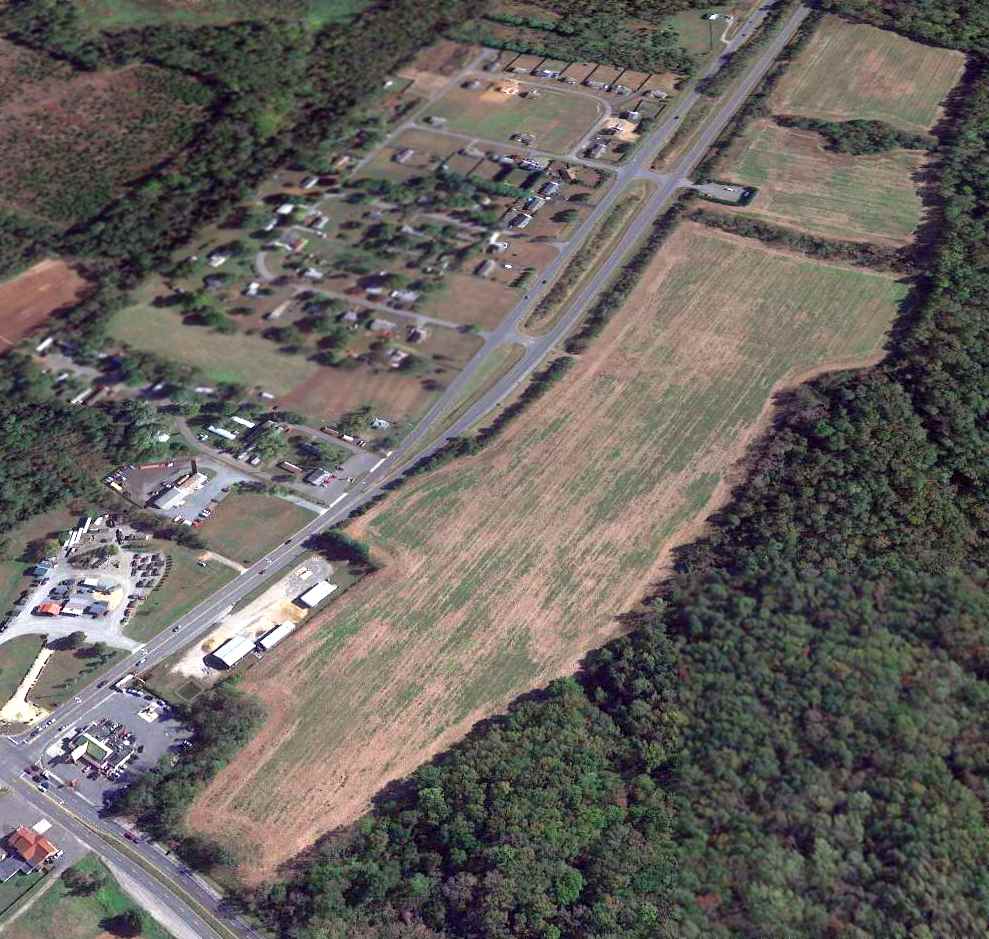
A 10/25/13 aerial view looking east showed no trace remaining of Port Royal AAF.
The site of Port Royal AAF is located south of the intersection of Route 301 & Route 17.
____________________________________________________
Moss Neck Army Airfield #3 / Pender Army Heliport, Moss Neck, VA
38.215, -77.309 (South of Washington, DC)
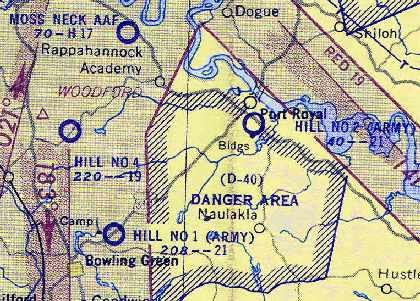
"Moss Neck AAF", as depicted on the January 1954 Washington Sectional Chart (courtesy of Chris Kennedy).
Photo of the airfield while in use has not been located.
The 76,000-acre Fort A. P. Hill was established as an Army training facility on 6/11/41.
During World War II, the Fort operated as a training site for corps & division-sized units.
The third of what would eventually total 4 airfields within the bounds of the Fort
was evidently established at some point between 1948-52,
as it was not yet depicted on the 1944 USGS topo map nor the October 1948 Washington Sectional Chart (courtesy of Chris Kennedy).
The earliest depiction of Moss Neck AAF which has been located was on the 1952 USGS topo map.
It depicted “Moss Neck Airstrip” as having 2 runways, with 2 small buildings northeast of the runway intersection.
The earliest aeronautical chart depiction of Moss Neck AAF which has been located
was on the January 1954 Washington Sectional Chart (courtesy of Chris Kennedy).
It described the field as having a 1,700 hard surface runway.
This would have made it the only one of the 4 A. P. Hill Army Airfields to have had a paved runway,
but this may have been an error on the part of the mapmakers,
as it was not repeated by later charts.

"Moss Neck AAF (#3)" was depicted on the 1960 Jeppesen Airway Manual (courtesy of Chris Kennedy)
as having 2 unpaved runways: a 1,700' Runway 18/36 & a 1,550' Runway 12/30.
Two small buildings (hangars?) were depicted northeast of the runway intersection,
but the field was described as unattended.

Moss Neck AAF #3 (and the other 3 Camp AP Hill Army Airfields), as depicted on the 1963 USGS topo map.
The earliest photo which has been located of Moss Neck AAF was a 1963 aerial view.
It depicted Moss Neck as having 2 grass runways, with 2 small buildings northeast of the runway intersection.
There were no aircraft visible on the field.
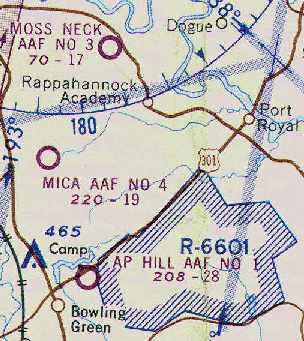
The October 1964 Washington Sectional Chart (courtesy of Chris Kennedy)
depicted "Moss Neck AAF #3" as having a 1,700' unpaved runway.
A 1966 aerial photo still depicted the 2 runways as remaining clear,
but the small buildings on the northeast side appeared to have been removed at some point between 1963-66.
A 1967 aerial photo depicted Moss Neck in an unchanged configuration.
Moss Neck AAF was still depicted as an active airfield
on the April 1969 Washington Sectional Chart (according to Chris Kennedy).
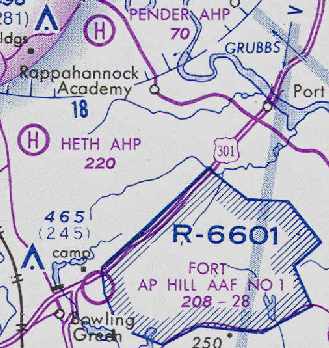
At some point between 1969-77, the field was downgraded to a heliport, and renamed "Pender AHP",
which is how it was depicted on the March 1977 Washington Sectional Chart (courtesy of Chris Kennedy).
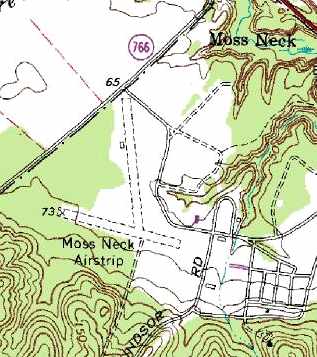
The 2 runways were still depicted as "Moss Neck Landing Strip" on the 1984 USGS topo map.
The last map depiction of the airfield which has been located was on the 1989 USGS topo map,
which depicted the 2 runways as the "Moss Neck Landing Strip".
The Pender Army Heliport was evidently closed at some point between 1977-93,
as it is no longer depicted at all on the March 1993 Washington Sectional Chart (courtesy of Carl Taylor).

As seen in the 1994 USGS aerial photo,
the 2 unpaved runways of the former Moss Neck AAF were still completely intact,
but there was no sign of any recent use of the airfield.
The 2001 USGS topo map continued to depict “Moss Neck Airstrip” as having 2 unpaved runways.
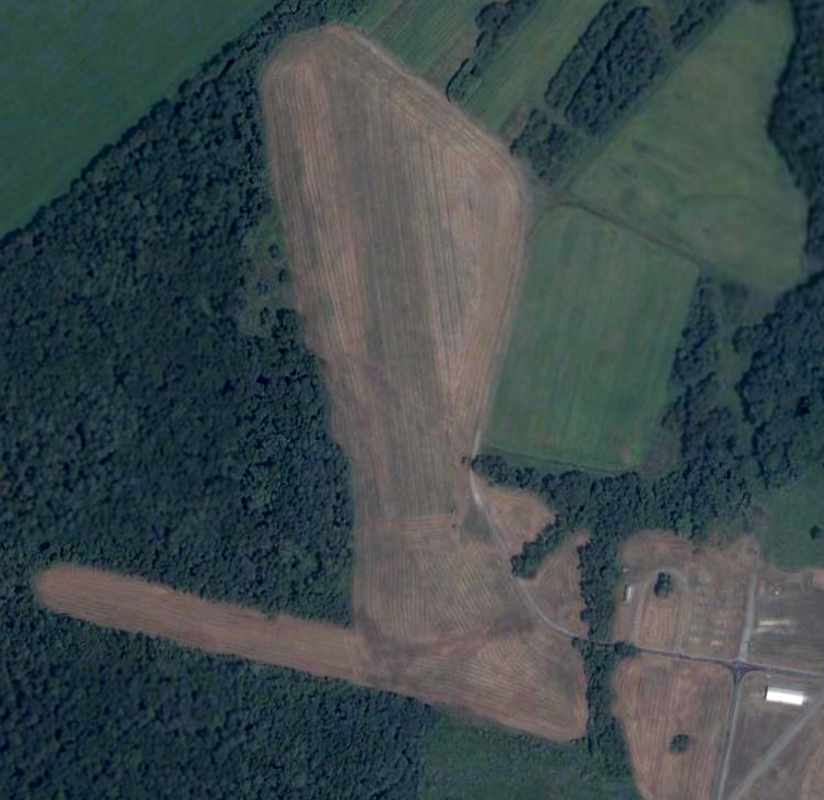
In a 2005 aerial photo, the 2 unpaved runways of the former Moss Neck AAF were still completely intact,
but there was no sign of any recent use of the airfield.
The site of Pender AHP is located west of the intersection of Pender Drive & Route 17,
at the very northern tip of he Fort A. P. Hill property.
____________________________________________________
Reno Skypark, Colonial Beach, VA
38.213, -77.013 (South of Washington, DC)

Reno Skypark, as depicted on the August 1957 Washington Sectional Chart (courtesy of Chris Kennedy).
This small general aviation airport was apparently built at some point in 1956,
as it was not yet depicted on the January 1956 Washington Sectional Chart (according to Chris Kennedy).
The earliest reference to the Reno Skypark which has been located
was in the April 5, 1956 issue of the "Potomac Interest" newspaper (courtesy of Orville Ingram).
The article read, “The new 'Reno Sky Port', an airfield for Colonial Beach, is now being used.
The new airport, 3.5 miles from Colonial Beach, on land belonging to Walter Massey, was put in use last week.
They have a runway one mile long, which will eventually enable any type plane to land on the field.
A telephone will soon be installed so that any plane using the field can obtain transportation.
Also aviation gasoline will be available & a hangar will be built.
Work has already started on getting the runway in shape.
Additionally work will be done in the near future to permit the full use of the field.
One or more regularly scheduled airlines are interested in running 'Champaign Flights' to Colonial Beach.
The new airfield is owned by Reno Pier.
They have been interested in locating an airfield at Colonial Beach for some time."

An undated photo (courtesy of Orville Ingram) of the 1st plane to land at Reno Skypark (an Aeronca?).
It was flown from Richmond by Dennis Conner & Jimmy Dyson.
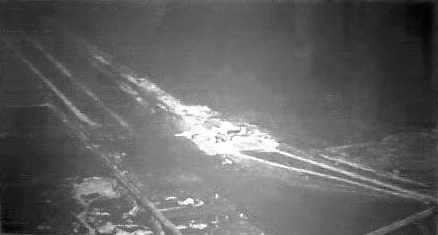
An undated aerial view of what appear to be several planes & a small hangar at Reno Skypark,
with the runway extending toward the top-right (courtesy of Orville Ingram).
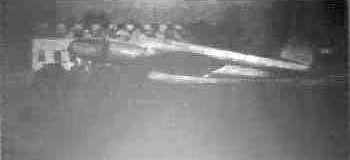
An undated photo (courtesy of Orville Ingram) of a twin-engine 18-seat Boeing 247D, painted pink, charcoal gray, and beige.
It was purchased in August 1956,
and was first used in the Fall of 1956 for "Champaign Flights" from Colonial Beach to Washington National Airport.
Three of the 4 Conner brothers that ran the Reno Air Park were Denning, Delbert and Paul.
The July 12, 1956 issue of the "Potomac Interest" newspaper (courtesy of Orville Ingram) described,
“On Tuesday, July 24, a charter flight of 2 DC-3s will fly into Reno Airpark from Alexandria.
They will be carrying more that 50 passengers between them.
This marks the first commercial flights into Reno Skypark.
After spending several hours at the Beach they will return to Alexandria late Tuesday night.
Lights for night take offs and landings are now being installed at the Airport.”
The September 13, 1956 issue of the "Potomac Interest" newspaper (courtesy of Orville Ingram) described,
“Delbert Conner, of Reno, Inc., bought a new twin-motor Apache 4-passenger plane last week.”
The earliest chart depiction of Reno Skypark which has been located
was on the August 1957 Washington Sectional Chart (courtesy of Chris Kennedy).
It depicted the field as having a 4,500' unpaved runway.
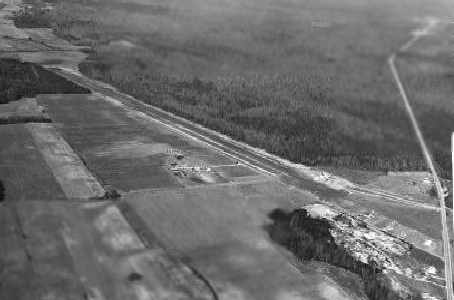
An undated aerial view looking north at the Reno Skypark.

The most detailed depiction which has been located of the Reno Skypark
was in the 1960 Jeppesen Airway Manual (courtesy of Chris Kennedy).
It depicted the field as having a single 3,500' unpaved Runway 14/32, along with 875' & 1,000' overruns.
Several buildings were depicted at the southeast end of the runway.

The last chart depiction which has been located of Reno Skypark
was on the 1960 Washington Sectional Chart (courtesy of Mike Keefe).
The Aerodromes table described the field as consisting of a single 3,500' turf runway.
Reno Skypark was not depicted on the 1961 USGS topo map.
Reno Skypark was evidently closed (for reasons unknown) at some point between 1960-64,
as it was no longer depicted all on the 1964 Washington Sectional Chart.
A 1967 aerial view depicted a dragstrip covering the former runway, along with a possible hangar at the southeast end.
The 1971 USGS topo map labeled the site as “Colonial Beach Dragway”.
Christopher Mallam reported in 2003, “I remember going to my Uncle's house in Colonial Beach about 20 years ago.
Right across the road was an abandoned airport.
At the far end was Colonial Beach Dragway,
but across the street, we would play in an old, run-down building that looked like a hangar.”

In the 1994 USGS aerial photo, what appeared to be the former runway was seen running parallel to the northeast side of the present-day dragstrip.
What appeared to be a former hangar was at the southeast corner of the photo.
The site of Reno Skypark is located northwest of the intersection of Route 205 & State Highway 631.
____________________________________________________
Harbor View Airport, Oak Grove, VA
38.202, -76.975 (South of Washington, DC)

Harbor View Airport, as depicted on the 1970 Washington Sectional Chart (courtesy of John Clifford).
This small general aviation airport was apparently built at some point between 1963-67,
as it was not listed in the 1963 AOPA Airport Directory (according to Chris Kennedy)
nor depicted on the 1963 USGS topo map.
The earliest depiction of Harbor View Airport which has been located was on a 1967 aerial photo.
It depicted the field as having a single northwest/southeast grass runway.
No aircraft were visible on the field.
The earliest aeronautical chart depiction of Harbor View Airport which has been located
was on the 1970 Washington Sectional Chart (courtesy of John Clifford).
It described the field as having a 2,600' unpaved runway.
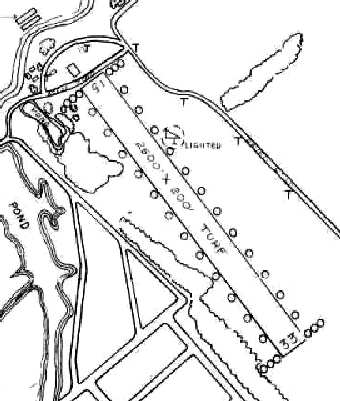
The 1970 VA Airport Directory (courtesy of Stephen Mahaley)
described Harbor View Airport as having a single 2,600' turf Runway 15/33.
It listed the operator as the Harbor View Yacht Club, and the manager was listed as Don Davis.
The 1971 USGS topo map depicted “Harbor View Airport” as having a single northwest/southeast runway.
Merton Meade recalled, “Harbor View was a lovely wee strip.
I went down there in the late Tom Selby's Fairchild 25 once. I had lunch nearby. Very nice grass.”

A June 15, 1973 aerial view by Kenneth Keeton looking northwest along Harbor View's Runway 33.

Harbor View Airport, as depicted on the 1975 Washington Sectional Chart (courtesy of Ed Drury).
The 1976 AOPA Airport Directory (courtesy of Chris Kennedy)
described Harbor View as having a single 2,600' turf Runway 15/33,
and described the field as unattended.
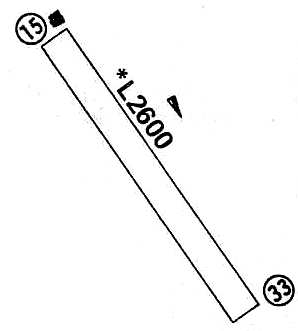
Harbor View Airport was still listed as an active airfield in the 1979 Flight Guide (courtesy of Chris Kennedy).
The 1985 USGS topo map depicted “Harbor View Airport” as having a single northwest/southeast runway.
Harbor View Airport was apparently closed (for reasons unknown) at some point between 1979-86,
as it was not listed in the 1986 Flight Guide (according to Chris Kennedy).

In the 1994 USGS aerial photo (taken after the field's closure),
the runway at Harbor View remained intact,
and at least 2 light single-engine aircraft appeared to be parked on the southern end of the runway,
along with a large number of other objects (trailers?).

A 10/25/13 aerial view looking northwest showed the runway at Harbor View to remain intact, but without any sign of recent aviation usage.
The site of Harbor View Airport is located northwest of the intersection of Route 664 & Oak Lane.
____________________________________________________
Since this site was first put on the web in 1999, its popularity has grown tremendously.
That has caused it to often exceed bandwidth limitations
set by the company which I pay to host it on the web.
If the total quantity of material on this site is to continue to grow,
it will require ever-increasing funding to pay its expenses.
Therefore, I request financial contributions from site visitors,
to help defray the increasing costs of the site
and ensure that it continues to be available & to grow.
What would you pay for a good aviation magazine, or a good aviation book?
Please consider a donation of an equivalent amount, at the least.
This site is not supported by commercial advertising –
it is purely supported by donations.
If you enjoy the site, and would like to make a financial contribution,
you
may use a credit card via
![]() ,
using one of 2 methods:
,
using one of 2 methods:
To make a one-time donation of an amount of your choice:
Or you can sign up for a $10 monthly subscription to help support the site on an ongoing basis:
Or if you prefer to contact me directly concerning a contribution (for a mailing address to send a check),
please contact me at: paulandterryfreeman@gmail.com
If you enjoy this web site, please support it with a financial contribution.
please contact me at: paulandterryfreeman@gmail.com
If you enjoy this web site, please support it with a financial contribution.
____________________________________________________
This site covers airfields in all 50 states.